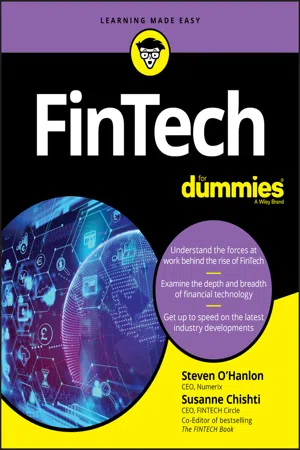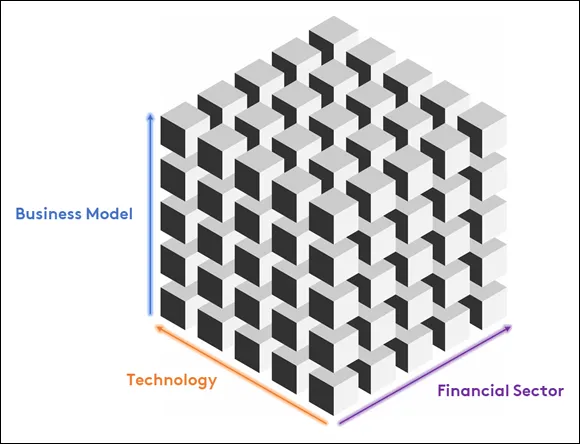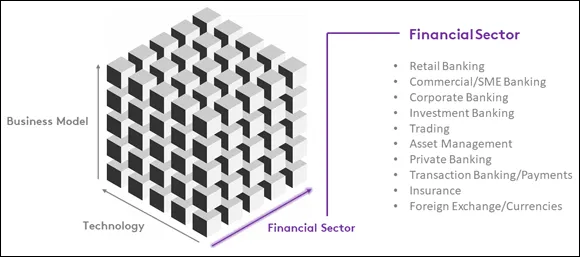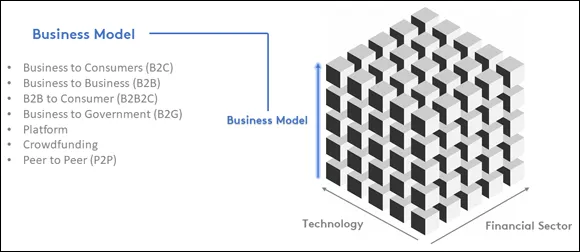
eBook - ePub
FinTech For Dummies
- English
- ePUB (mobile friendly)
- Available on iOS & Android
eBook - ePub
FinTech For Dummies
About this book
Examine the depth and breadth of financial technology This comprehensive, hands-on guide is the go-to source for everything you need to confidently navigate the ever-changing scene of this booming industry. FinTech For Dummies will shed light on this rapidly changing landscape making it an invaluable source of information for anybody working in or interested in this space. This book provides insights, knowledge and guidance from industry experts Steve O'Hanlon and Susanne Chishti on the following:
- Gaining insight fastest growing market segment of the financial markets
- Learning the core decision making to effect a growth plan
- Securing knowledge of the fastest growing fintech companies in the world
- Navigating the fintech world
- The ingredients into building a FinTech company
Frequently asked questions
Yes, you can cancel anytime from the Subscription tab in your account settings on the Perlego website. Your subscription will stay active until the end of your current billing period. Learn how to cancel your subscription.
No, books cannot be downloaded as external files, such as PDFs, for use outside of Perlego. However, you can download books within the Perlego app for offline reading on mobile or tablet. Learn more here.
Perlego offers two plans: Essential and Complete
- Essential is ideal for learners and professionals who enjoy exploring a wide range of subjects. Access the Essential Library with 800,000+ trusted titles and best-sellers across business, personal growth, and the humanities. Includes unlimited reading time and Standard Read Aloud voice.
- Complete: Perfect for advanced learners and researchers needing full, unrestricted access. Unlock 1.4M+ books across hundreds of subjects, including academic and specialized titles. The Complete Plan also includes advanced features like Premium Read Aloud and Research Assistant.
We are an online textbook subscription service, where you can get access to an entire online library for less than the price of a single book per month. With over 1 million books across 1000+ topics, we’ve got you covered! Learn more here.
Look out for the read-aloud symbol on your next book to see if you can listen to it. The read-aloud tool reads text aloud for you, highlighting the text as it is being read. You can pause it, speed it up and slow it down. Learn more here.
Yes! You can use the Perlego app on both iOS or Android devices to read anytime, anywhere — even offline. Perfect for commutes or when you’re on the go.
Please note we cannot support devices running on iOS 13 and Android 7 or earlier. Learn more about using the app.
Please note we cannot support devices running on iOS 13 and Android 7 or earlier. Learn more about using the app.
Yes, you can access FinTech For Dummies by Susanne Chishti,Steven O'Hanlon,Brendan Bradley,James Jockle,Dawn Patrick in PDF and/or ePUB format, as well as other popular books in Business & Financial Engineering. We have over one million books available in our catalogue for you to explore.
Information
Part 1
Getting to Know FinTech
IN THIS PART …
Check out what FinTech is, understand its impact, and look at the FinTech landscape.
Find out how FinTech has been disrupting the financial industry, challenging traditional financial institutions to “grow or die,” and creating opportunities for innovative start-up companies to claim a share of the pie.
Discover the role of regulation in FinTech, examine recent regulatory changes, and meet regulators in the United States and Europe.
Chapter 1
Navigating the FinTech Landscape
IN THIS CHAPTER





FinTech has undoubtedly become one of the hottest topics in business. Web searches for the term fintech in Google have grown exponentially in the last several years, so it’s obvious that people are curious about it. But what is it, and why is it relevant to today’s financial industry? This chapter looks at those very basic questions, helping prepare you for the more detailed information you discover later in this book.
What Is FinTech, Anyway?
FinTech is also frequently used as an umbrella term for various subcategories, such as WealthTech and RegTech. You find out more about these subcategories in Chapter 2.
Analyzing FinTech’s Dimensions
- Which part of finance is being impacted (financial sector)?
- Which business model is being used?
- Which technology is being used?
FINTECH Circle has coined the term Fintech Cube to describe the intersections of these factors. Figure 1-1 illustrates this cube, in which there are three axes: the financial sector on the x-axis, the business model on the y-axis, and technology on the z-axis.

Source: FINTECH Circle, 2020
FIGURE 1-1: The Fintech Cube combines financial sector, business model, and technology factors.
Each of these dimensions can be further categorized. For example, Figure 1-2 expands on the concept by adding key areas of financial services that can benefit from FinTech. All financial sectors are shown on one side of the cube, including retail banking, trading, and insurance (among others).
Figure 1-3 summarizes the most important business models from business-to-consumer (B2C), business-to-business (B2B), business-to-business-to-consumer (B2B2C), to business-to-government/regulator (B2G), to platform-based business models, crowdfunding, and peer-to-peer (P2P) lending.

Source: The Fintech Cube, FINTECH Circle, 2020
FIGURE 1-2: Key areas of financial services that benefit from FinTech.

Source: The Fintech Cube, FINTECH Circle, 2020
FIGURE 1-3: A dimension of main business models.
Figure 1-4 shows the third dimension — the technology being used, which can range from cloud computing, big data, artificial intelligence (AI)/machine learning (ML), blockchain (distributed ledger technologies), the Internet of Things (IoT), and quantum computing, to augmented and virtual reality. Part 2 covers these technologies in more detail.
FinTech start-ups, for example, can now be more easily categorized and compared. For example, you may have a retail banking (financial sector x-axis) solution focused on the business model of B2C and using various technologies, such as cloud, big data analytics, and AI. Such a company would be called a challenger bank, sometimes also referred to as digital bank or neo-bank.
Table of contents
- Cover
- Table of Contents
- Introduction
- Part 1: Getting to Know FinTech
- Part 2: Learning the Technology
- Part 3: Working with FinTech Companies
- Part 4: The Part of Tens
- Appendix: Building a FinTech Company from the Ground Up
- Index
- About the Authors
- Advertisement Page
- Connect with Dummies
- End User License Agreement
